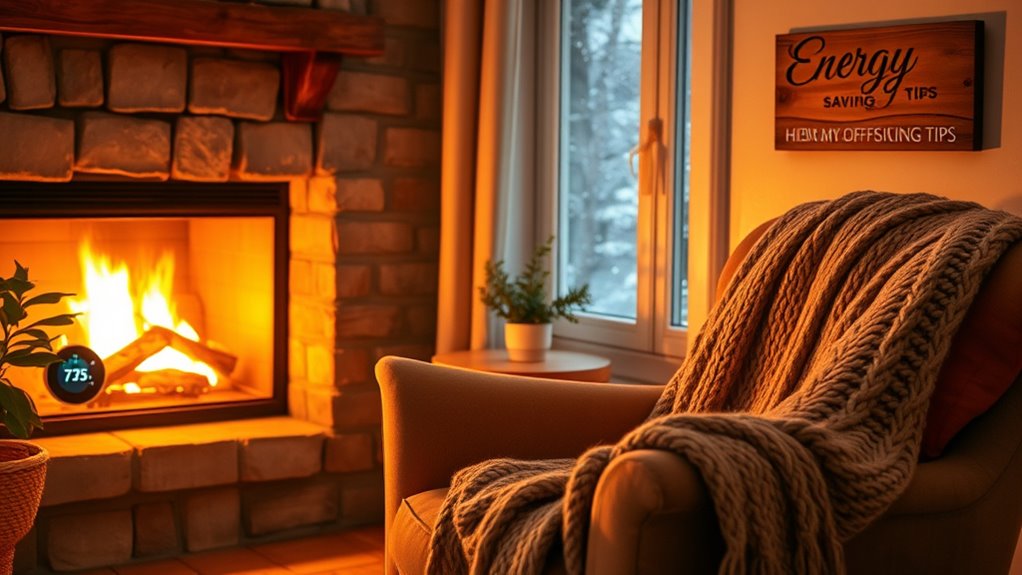To cut your winter heating bills, start by upgrading your home’s insulation, especially in the attic, basement, and exterior walls, to prevent heat loss. Installing a smart thermostat allows you to control and optimize your heating schedule remotely, saving energy when you’re away or asleep. Combining insulation with a smart thermostat creates a more efficient home, reducing costs and environmental impact. Keep exploring for more tips to make your home warmer and more affordable this winter.
Key Takeaways
- Upgrade to a smart thermostat to automatically optimize heating schedules and reduce energy waste.
- Improve home insulation, especially in attics, walls, and floors, to retain heat and lower heating costs.
- Seal drafts around windows and doors to prevent heat loss and enhance overall home warmth.
- Lower your thermostat setting during nighttime or when away to decrease unnecessary energy consumption.
- Perform regular maintenance on your heating system, such as cleaning filters and inspecting for efficiency.

Are you looking for simple ways to cut down your energy bills and reduce your environmental impact? If so, upgrading your home’s heating efficiency is a smart move. Two effective strategies are installing smart thermostats and making insulation upgrades. These improvements can dramatically lower your heating costs this winter while helping the planet.
Smart thermostats are a game-changer. They allow you to control your home’s temperature remotely via your smartphone, giving you the flexibility to adjust settings when you’re not home or asleep. Many models learn your schedule over time, automatically lowering the heat when you’re away or asleep and raising it before you wake up or return home. This automation prevents unnecessary heating, saving you money without sacrificing comfort. Plus, smart thermostats provide detailed energy usage reports, so you can identify patterns and make further adjustments to maximize efficiency. With a simple installation, you’ll notice the difference in your energy bills within just a few months.
Control your home’s temperature remotely with smart thermostats that learn your schedule and save energy effortlessly.
Next, consider insulation upgrades. Proper insulation keeps warm air inside your home, preventing heat loss through walls, floors, and attic spaces. If your home’s insulation is outdated or insufficient, you’re likely spending more on heating because your system has to work harder to maintain a comfortable temperature. Upgrading your insulation can be a straightforward and cost-effective way to improve energy retention. Focus on critical areas like your attic, basement, and exterior walls. Adding insulation in these zones reduces drafts and keeps heat from escaping, which means your furnace doesn’t have to run as often or as long. Not only does this cut your heating bills, but it also enhances your home’s overall comfort by eliminating cold spots and drafts. Additionally, addressing poor insulation can prevent heat from leaking out, making your upgrades even more effective.
Combining these two strategies amplifies their benefits. A smart thermostat ensures your heating is only active when needed and at suitable settings, while insulation upgrades prevent heat from leaking out in the first place. Together, they create a more energy-efficient home that stays warmer longer and costs less to heat. Furthermore, these upgrades are investments that pay off over time, often recouping their costs through energy savings. You’ll find yourself less dependent on your heating system, which is especially valuable during the coldest months. Not to mention, reducing your energy consumption helps lower your carbon footprint, contributing to a healthier environment.
Frequently Asked Questions
How Can I Tell if My Home Is Well-Insulated?
You can tell if your home is well-insulated by checking for thermal leaks around windows, doors, and electrical outlets. Feel for drafts or cold spots, especially near exterior walls. Inspect insulation types in your attic and walls—if they appear compressed or thin, they might need upgrading. Consider professional assessments or using a thermal camera to identify hidden leaks, ensuring your home retains heat efficiently.
Are Programmable Thermostats Worth the Investment?
Yes, a smart thermostat is worth the investment because it helps you optimize your heating schedule, leading to significant energy savings. You can program it to lower temperatures when you’re away or asleep, reducing unnecessary energy use. Plus, many models learn your preferences over time, further enhancing efficiency. Over time, the savings on your energy bills often outweigh the initial cost, making it a smart choice for better home climate control.
What Are the Best Window Treatments for Winter Warmth?
You should choose heavy curtains or thermal window shades to keep the cold out and add an extra layer of insulation. Installing window insulation kits or using draft stoppers around the window frames can considerably reduce heat loss. These treatments work together to trap warm air inside and block cold drafts, making your home warmer and more energy-efficient during winter. Combining these options offers the best winter warmth.
How Often Should I Service My Heating System?
You should schedule HVAC maintenance at least once a year, ideally before winter hits. Regular servicing helps guarantee your heating system runs efficiently, extends its lifespan, and reduces breakdowns during cold months. During maintenance, a professional checks for issues, cleans components, and replaces filters if needed. Staying on top of this keeps your system in top shape, saving you money and providing reliable warmth throughout winter.
Can Plants Help Improve Indoor Heating Efficiency?
Imagine plants transforming your home into a cozy oasis—yes, they can help improve indoor heating efficiency! Indoor plant benefits include adding humidity and warmth, making your space feel more inviting. Place plants near windows or vents for maximum effect, and avoid drafty areas. With the right plant placement tips, you’ll not only enjoy a greener home but also a warmer, more comfortable environment, reducing your heating needs naturally.
Conclusion
By implementing these energy-saving tips, you can reduce your heating bill and stay cozy all winter. It might seem that sealing drafts and adjusting your thermostat won’t make a big difference, but studies show small changes add up over time. In fact, insulating your home properly has been proven to save up to 20% on heating costs. So, take these steps seriously—you’ll save money and enjoy a warmer, more efficient home all season long.









